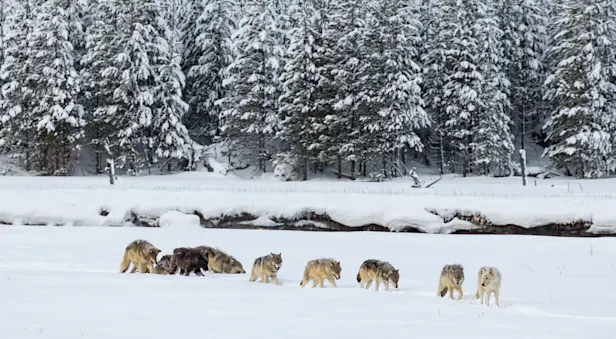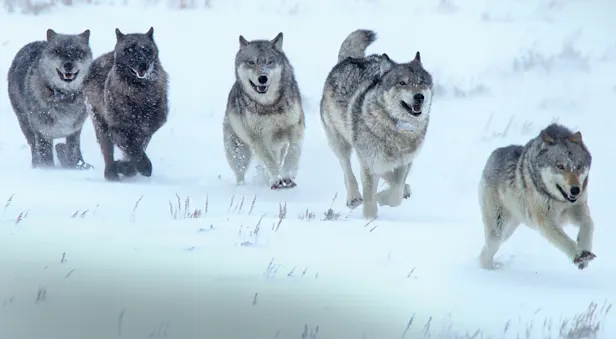Know Before You Go
What to Pack for the Winter Season in Yellowstone
This packing list contains general recommendations for a Yellowstone winter safari. If you are currently booked on a Yellowstone adventure with Nat Hab, please consult your pre-departure materials for the most up-to-date packing list specific to your trip. You will receive these pre-departure materials 60-90 days before your departure.
Items indicated in color below are typically available in the Nat Hab Gear Store. Please note that due to global supply chain issues beyond our control, we cannot guarantee that every item will always be in stock.
Adventure Guidelines
Keep in mind that winter temperatures in Yellowstone National Park can be extremely cold, often hovering near 0°F during the day (and can dip well below zero). Be sure you're properly prepared with warm outerwear. We can't stress this enough!
At any time of year, it is important to be prepared for sudden weather changes. Unpredictability, more than anything else, characterizes Yellowstone’s weather. To prepare for variable temperatures, bring very warm layers of clothing, including heavyweight long underwear, heavy insulated mittens or ski gloves, a warm hat, and rain/snow gear.
Bring extra layers with you every day to ensure you stay warm while participating in outdoor activities.
A winter parka and boots are provided for all travelers while on this adventure. If you wish to use them, please indicate your size on the form provided with your Confirmation Package. (Call our office if you require an especially large or small size, as we may be unable to accommodate you.) You will still need to bring warm pants (insulated ski pants are ideal), as well as a warm hat, scarf and gloves. Hand warmers (limited supply) will also be provided on outings.
If you have your own gear, we highly recommend bringing it to ensure your comfort and a proper fit.
Wear water-repellent outer garments that will keep you dry on the outside and still breathe so that moisture from your body can escape.
Body heat is most likely to be lost from the head, hands and feet. It is important to keep them warm and dry, which can be a challenge. A warm hat is critical. Thin polypropylene gloves can be worn underneath heavy, insulated mittens or ski gloves. (For warmth, mittens are better than gloves.) If you have liners, you can take off the mittens to operate your camera and still have some protection from the cold. It is a good idea to bring an extra pair of mittens in case your other pair gets wet (or lost).
Warm wool socks worn over silk or polypropylene liners will provide more insulation for your feet. Bring several pairs.
Dress in comfortable, loose layers. In the cold, it is far better to wear layers of relatively light, loose clothing than one thick or heavy item. Between each layer, a film of trapped air is heated by your body, providing excellent insulation.
Wool and silk are superior to cotton because they trap warm air. Synthetic fabrics that spring back into shape after compression are also good. When damp or wet, polyester fiberfill is better than goose or duck down. Polar fleece is also recommended.
It is crucial to bring a high SPF sunscreen for your lips, hands and face, as the reflected glare from snow and ice can be intense, especially at higher altitudes.
Each vehicle will have a few spotting scopes on board to use in the field, and binoculars will also be available. Therefore, you only need to bring your own if you prefer your personal optics.
Clothing
Lightweight neck gaiter (included in your pre-departure package)
—Provides sun, wind and/or dust protection.Warm winter coat or parka (with a hood)
— Provided by NHAWaterproof or snow-resistant pants (ski pants are good if you have them—pants that zip or cover boots are best)
Warm, waterproof boots
— Provided by NHA. Wool-lined “pac boots,” such as Sorels, are highly recommended—make sure they're large enough to accommodate heavy wool socks without constricting your feet.Wool or other warm hat, neck gaiter or scarf, and HEAVY ski gloves or insulated mittens—extremely important!
— Make sure your hat covers your ears. Please do not bring thin gloves or hats, as your hands and head will definitely get cold! If you are sensitive to cold temperatures, you may also wish to bring a ski mask or balaclava that covers the entire face.Warm socks
— Several pairs of moisture-resistant or moisture-wicking wool or synthetic socks. Cotton socks are not recommended.Wool, silk or polypropylene thermal underwear (bottoms and top)
Silk, polypropylene or thin wool liners for hands and feet
Warm sweater, fleece and/or sweatshirt
Turtleneck shirts (for layering—synthetic material is best)
Warm, comfortable pants
Undergarments
Sleepwear
Swimsuit (optional)
Extra pair of comfortable shoes (with slip-resistant soles to wear after outdoor excursions)
Hat with brim (optional—for sun protection, to wear under your warm hat if you are sensitive to the sun)
Additional Items
Cash
— For discretionary gratuities (you may want to bring envelopes for discreet presentation)
— For personal spending (souvenirs, Internet use, or food and beverages not included in your trip fee)Hair dryer
— Provided at all accommodations, but some hotels keep only a few at the front desk, and there is a possibility they may already be in use by other guestsSmall, water-resistant daypack (to carry camera gear and other equipment during hikes)
Hand/foot warmers
— NHA will provide a limited supply, but you may want to bring your own to supplementReusable water bottle (included in your pre-trip package)
—In our continuing effort to operate our adventures with as little impact on the environment as possible, you will receive a reusable water bottle (unless you opted out on your Booking Form) to take with you on your adventure. We will provide drinking water throughout the adventure for you to refill your bottle. By doing this, you will avoid using multiple disposable plastic bottles.Binoculars
— Optional. Vortex Diamondback 10x42 binoculars will be provided for each traveler, but if you have a pair you especially like, you are welcome to bring them.Sunglasses (With U.V. filter and secure strap)
Gripping device for shoes (such as Yaktrax)
— We have a limited supply available for guest use, but if you want guaranteed use during your trip, we recommend bringing your own
— Walking conditions can be icy on a daily basis—gripping devices are essential when walking around the geyser basins
— These devices MUST be removed each time you enter a vehicle or building, as they can do significant damage to the floor and seatsHeadlamp or small flashlight
Earplugs
Toiletries
Prescription medications and favorite remedies (for headaches, colds, upset stomach, etc.)
Sunscreen and lip balm (at least SPF 15, ideally SPF 30 or higher)
Hand sanitizer
Prescription glasses/contact lenses
Bandana/handkerchief (for runny noses)
Battery-operated alarm clock/wristwatch
Dry bags or reusable waterproof bags (several sizes for wet or dirty clothing, and to protect camera equipment)
Telescoping walking poles
— With spikes appropriate for icy conditions, if you require walking assistance. NHA will have a few on hand to loan out, but we may not have enough for the entire group.
— If you are bringing walking poles, they must fit in your checked luggage, as you will not be allowed to carry them on the plane.Phone card (Cooke City does not have cell phone coverage.)
Header Credit: Henry Holdsworth
Visit Yellowstone in Winter on These Trips

Yellowstone: Ultimate Wolf & Wildlife Safari
Track elusive wolves plus abundant bison, elk, moose and other wildlife, and witness geothermal phenomena amid the snowy splendor of Yellowstone and Grand Teton national parks.


Yellowstone Winter Wildlife Photo Expedition
Capture frosty wildlife images in winter solitude in Yellowstone and Grand Teton—go deep into the silent wilds by snowcoach, shoot dramatic landscapes, and photograph roaming elk in Jackson Hole.
























